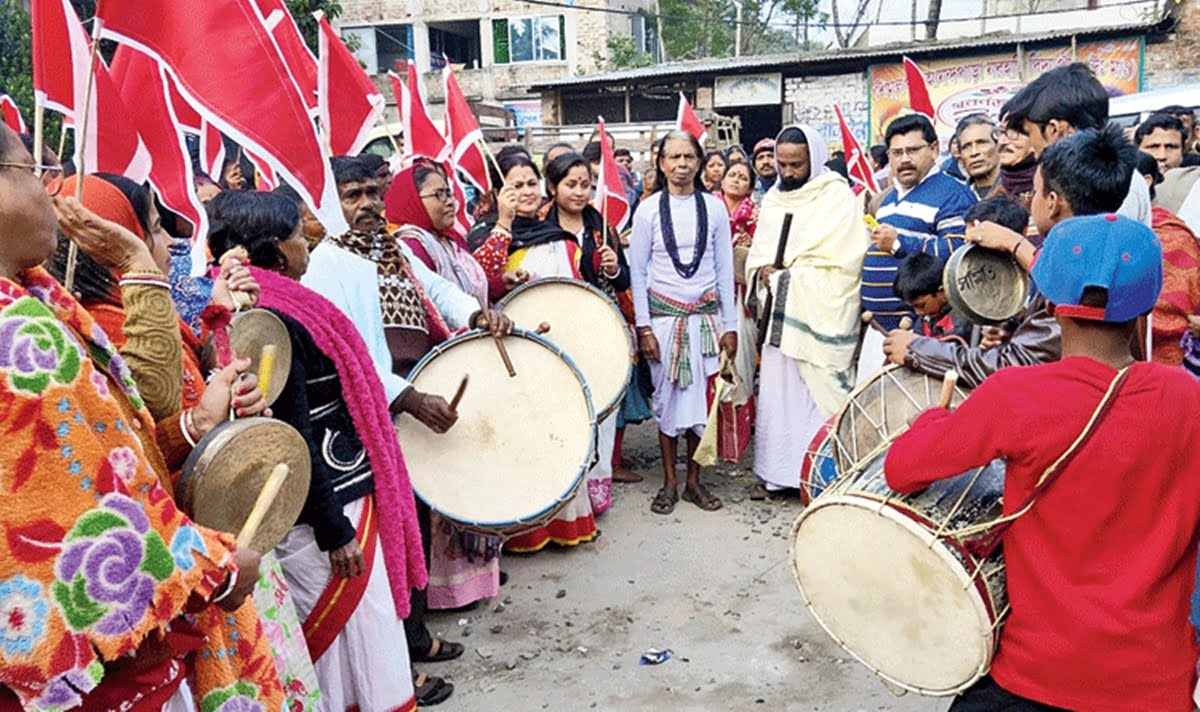The Namasudras were Dalits from Bengal who resided originally in present day Bangladesh, but had to relocate to Bengal after the partition. There have been extensive studies on this community by various scholars but very few of them have delved into their culture that proved to be their door to deliverance from social exclusion and deprivation that were sanctioned on them by the dominant caste communities.
The cultural revolution in this community was brought by Sri Harichand Thakur of Orakandi of Bangladesh. His efforts made it possible for the Chandals to come together under the banner of the Matua Sect, for the very first time. The ‘Matuas’ were “drunk in devotion” which gained them the title (‘মত্ত্য’, which means drunk in Bengali). It was for the first time in history that a mass mobilisation of Namashudras had taken place under one collective through an art form.
Harichand Thakur’s way of mobilising the Namashudras was by introducing kirtan or naamgaan — songs of devotion to Radha-Krishna through a shared experience, which in turn reinforced a collective identity of the community.
Also read: To The Bhadralok Academia, With Love
Kirtan or devotional songs had existed way before Harichand’s introduction of it to the Matuas. They were originally popularised by Sri Chaitanya in the 16th Century and was a one of a kind art form where people shed all their social attributes and immersed themselves in the holy atmosphere.
But although there were no social inhibitions among the people involved in kirtan in Chaitanya’s time, his compositions never went against the caste system like devotional songs of other spiritual leaders like Kabir. It was Harichand’s kirtan or naamgaan which aimed at social regeneration and the celebration of the subaltern. Harichand’s naamgaan were a form of creating an egalitarian society with no hierarchies at play. Some songs helped not only the Namasudras, but also other downtrodden sections of the society, assert their collective will and raise their voice against any injustice that they had to face earlier.
“জার দল নে ই, তার বল নে ই।”
(one who does not have a group, does not have any power)
Harichand Thakur’s kirtan sabhas were a place where people from all castes and classes were welcome. The sole fact that he himself was a Brahmin who married a Namashudra gave impetus to the whole movement and paved the way for the “low borns” to gain independence from the social norms of the time.
The naamgaan were different from the classical songs of the Bhadralok. They were the songs of Chhotolok — songs with no raag or gourchandrikas; songs for the people who wanted to break free from the shackles of the caste system and liberate themselves from the upper-caste suppression.
In the 1880s, while the Bhadrolok culture of Bengal was booming and everyone spoke of high cultural values, Harichand’s naamgaan taught the art of minimalist living through simple teaching methods which violated the rules of the then Brahmin teachings. He moulded the high-cultured kirtans of Chaitanya into songs of the Chhotoloks.
Also read: FII Interviews: Ambedkarite Activist Suvarna Salve
The Matuas believed in equality of all living beings and preached living a simple and happy life. Harichand Thakur also propagated the potential that Matuas had in the real world if they came out of their unquestioning faith in religion. The “Hari Sabha” was a place where words of education and gender equality were sung collectively.
Hari’s sabhas, apart from being a manifestation of protest against societal norms, were also a way to teach people to generate an idea of the ‘self’. Songs were composed to formulate confidence in the hearts of the people who had been victims of systemic oppression and faced violation of their rights for generations.
ভাবনা আর করি স কি ,
বে চেঁচে থে কে মরি স কি ?
জাগ ো, জাগ ো, জাগ ো বীর,
স োজা করে রাখ ো শি র,
যাক জান, বে চেঁচে থাক মান।
(What are you thinking? Are you going to behave as if you are dead? Hold your heads high, do not give up self – respect, even if you have to sacrifice your life.)
If we ignore the politics of the movement, we can probably view it from another perspective. These kirtan sabhas were also a way to showcase the aspirations of the historically subordinate groups who wanted to find their place in the existing structures of power in the society.
In contemporary times, the population of the Matua sect is more than a crore and it is spread over North Bengal, Nadia and North 24 Parganas. People still chant “Hari naam” in kirtan sabhas in villages. They celebrate freedom, love, life and devotion to their lord Krishna.
Debarati Mitra is a second year student doing her bachelor’s in Sociology in Maitreyi College, University of Delhi. You can find her on Instagram and Facebook.
Featured image source: Telegraph India




